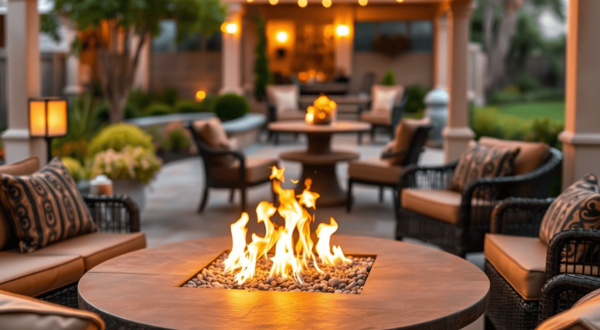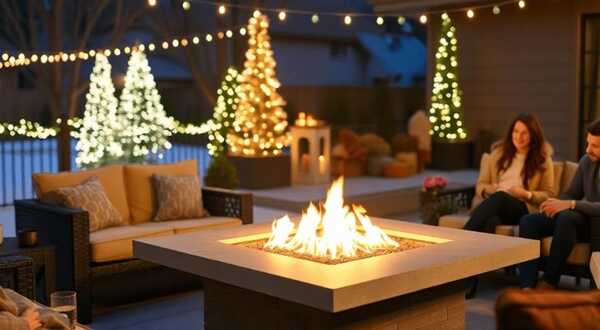
Understanding BTU is essential for creating the perfect outdoor ambiance. BTU, or British Thermal Unit, measures the heat output of a fire pit, directly influencing its efficiency and warmth.
For instance, the York Fire Pit creates a dramatic focal point in any outdoor space while providing ample warmth. Similarly, the Venice fire table serves as both a cozy gathering place and an aesthetic enhancement to your outdoor living area.
Key takeaway: Grasping BTU ratings is vital for selecting the right fire pit to meet your heating needs and aesthetic preferences. Whether you're exploring options for outdoor patio fire pits or seeking specific features, understanding these elements will guide you towards making an informed decision.
BTU rating is an essential measurement for fire pits, indicating the heat output. BTU stands for British Thermal Unit, which measures the amount of heat needed to raise the temperature of one pound of water by one degree Fahrenheit. In the context of fire pits, it directly relates to the intensity of heat produced.
Knowing how BTU ratings affect performance is important when choosing a fire pit that suits your heating needs and preferences. Generally, a higher BTU rating means more heat output, which can greatly improve the comfort of your outdoor area during chilly evenings. On the other hand, a lower BTU rating may be sufficient for milder climates or smaller spaces.
Example: A backyard fire pit with a high BTU rating will provide ample warmth for larger gatherings, while a lower BTU unit might be ideal for intimate settings or smokeless fire pits designed for ambiance over heat.
Different types of fire pits have varying heat outputs depending on their fuel sources:
For instance:
While high BTU ratings indicate greater heat output, it's crucial to balance this with energy efficiency. Each type of fuel—wood, natural gas, propane—has its own efficiency characteristics:
Therefore, selecting the right BTU rating involves evaluating your specific heating needs along with practical factors such as space dimensions and fuel availability.
By grasping these aspects of BTU ratings and their effects on performance and efficiency, you can make a well-informed choice tailored to your outdoor heating requirements. Whether you're contemplating a sleek Boulder Fire Table or a charming Nantucket Fire Pit, knowing how to interpret these ratings will assist you in finding the ideal fit for your space.
When selecting a fire pit for your outdoor area, it's important to find the right balance between BTU output and the size of your space. The fire pit selection guide provides a helpful framework to ensure you have the perfect amount of heat without overwhelming or underwhelming your environment.
Larger areas can accommodate higher BTU outputs, providing substantial warmth and ambiance. Conversely, smaller spaces benefit from lower BTU ratings to maintain comfort without excessive heat.
Example: A spacious patio may require a fire pit with 50,000 to 100,000 BTUs, while a compact balcony might be best served by a unit offering 30,000 to 40,000 BTUs.
Determine whether the primary function of your fire pit is heating, cooking, or aesthetic enhancement. Higher BTUs are ideal for heating large gatherings or cooking, while lower BTUs suffice for ambiance.
Example: For alfresco dining experiences like those provided by the Sonoma Dining Table Fire Pit, a middle-range BTU output around 45,000 is often ideal.
Each fuel source—wood, propane, natural gas—has distinct performance characteristics that influence your choice.
Example: Propane fire pits such as the Exeter Fire Column typically range from 40,000 to 50,000 BTUs and offer convenient ignition systems suitable for varied outdoor settings.
Understanding these factors ensures that your chosen fire pit not only meets your heating needs but also complements the layout and functionality of your outdoor living space.
When selecting a fire pit, choosing the right fuel type is paramount. Each option offers unique benefits and considerations:
Wood-burning fire pits are synonymous with traditional campfires. They provide a rustic charm and authentic crackling sounds that many find irresistible. These fire pits can reach high BTU outputs, ranging from 30,000 to 100,000 BTUs, making them ideal for larger outdoor spaces. However, wood burning requires more maintenance, produces smoke and ash, and necessitates a consistent supply of firewood.
Propane fire pits are known for their convenience and ease of use. With an output ranging from 40,000 to 150,000 BTUs, they offer adjustable heat settings and cleaner combustion compared to wood. Propane is stored in portable tanks, making these fire pits highly versatile and suitable for various outdoor settings. The downside includes the recurring cost of propane refills and the need for proper tank storage.
Connected directly to your home's gas line, natural gas fire pits provide a continuous fuel supply without the need for refills. They typically offer BTU outputs between 30,000 and 60,000, providing steady heat for extended periods. These fire pits are eco-friendlier than wood-burning options but require professional installation and are less portable due to their fixed gas lines.
An emerging option in the market, bioethanol fire pits use ethanol derived from plants as fuel. They burn cleanly without producing smoke or harmful emissions. These fire pits generally have lower BTU outputs, around 10,000 to 20,000 BTUs, making them more suitable for smaller spaces or decorative purposes rather than primary heating sources.
Understanding the heat output and efficiency of each fuel type helps in selecting the right fire pit:
The choice between wood burning vs propane vs natural gas vs bioethanol fire pits ultimately depends on your specific needs—whether you prioritize heat intensity, convenience, environmental impact, or aesthetic appeal. Understanding these nuances ensures you select a fire pit that perfectly complements your outdoor space while meeting your heating requirements efficiently.
When selecting the ideal fire pit, a comprehensive assessment of your outdoor space is paramount. Here's what to consider:
Choosing between portable and built-in fire pits depends on your specific needs and preferences.
Portable fire pits offer flexibility, convenience, and are typically simpler to install.
Built-in fire pits provide permanence, customization, and often integrated into larger landscaping projects.
Understanding BTU ratings in conjunction with these factors ensures you select a fire pit that not only fits your space but also meets your heating demands effectively.
Selecting the right design can transform your outdoor space into a captivating retreat. Here are some popular design aesthetics:
Each style offers a unique ambiance, allowing you to create an outdoor space that reflects your personal taste.
When choosing an outdoor fire pit, certain features are essential for both performance and user convenience:
Investing in these functionalities ensures a seamless and enjoyable fire pit experience.
Understanding BTU: How to Choose the Right Fire Pit for Your Needs is essential, but prioritizing safety ensures a worry-free experience. Here are critical fire pit safety precautions during operation:
Adhering to these guidelines helps create a secure environment around your outdoor fireplace.
Enhancing the warmth and comfort of your outdoor space requires strategic planning and thoughtful execution. Here are some practical tips to optimize warmth retention in outdoor fireplaces:
Position seating close to the fire pit, but not too close to compromise safety. An ideal distance allows for maximum heat distribution while maintaining comfort. Circular seating arrangements can promote even heat circulation.
Utilize windbreaks or screens to shield the fire pit area from prevailing winds. This not only prevents heat from being carried away but also enhances the overall ambiance by creating a cozier environment.
Consider adding insulating materials like fire-resistant mats or blankets around the perimeter of your seating area. These materials help retain heat and provide additional warmth.
Incorporate reflective surfaces such as stainless steel or aluminum panels around the fire pit. These surfaces reflect and distribute heat more effectively, ensuring that you make the most of your BTU output.
When not in use, cover your fire pit with a high-quality cover. This helps retain residual heat and protects against elements that could cool down the structure unnecessarily.
Invest in a fire pit with adjustable flame control mechanisms. This feature allows you to regulate the intensity of the flame according to your heating needs, maximizing both efficiency and comfort.
By implementing these suggestions, you ensure that your fire pit operates at peak performance, providing optimal warmth during those chilly evenings.



| Call Us : Local: (905) 761-8930 Toll Free: (888) 974-3379 |